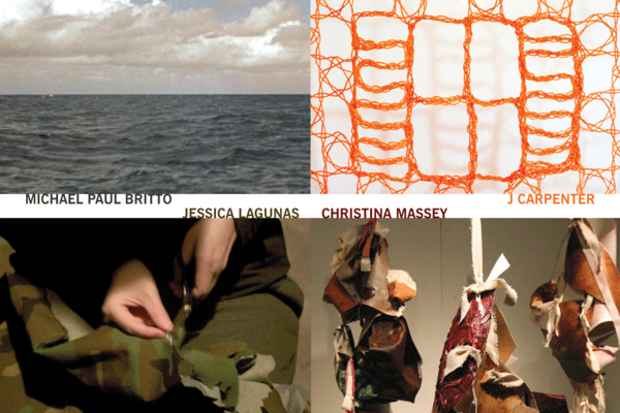Michael Paul Britto "THE COST OF FORGETTING", J Carpenter "LIVE WIRES", Jessica Lagunas "TRACING MEMORIES" & Christina Massey "MEAT MARKET"
Taller Boricua

This event has ended.
As part of our 40th anniversary celebration, the Taller Boricua presents the third and last in our series of multiple, solo exhibitions by artists who share facets of our mission: art and aesthetics, community, art activism as well as music and performance.
Michael Paul Britto’s exhibition “The Cost of Forgetting” confronts the issues of racism and identity politics through both a historical and contemporary lens. His work examines the current manifestations and consequences of the ongoing inequality in America and the price society pays for its denial. His video “And They Sold Us Like Beasts” is created from a looped scene of a slave ship crossing the ocean from the film “Roots.” Seen from the inside of the hull looking out toward the waves, the piece encourages a visceral and immediate sense of empathy and humanity to the logically incomprehensible atrocities of the past, allowing for honest, open discourse in the present. Although slave ships no longer exist, the sense of powerlessness and injustice driven by discrimination is still prevalent today. “Who Has the Power?” consists of a life size Ku Klux Klan robe made from African style textiles accompanied by a video depicting the transformation. By switching the semantics of the historical language of dominance and oppression, Britto empowers viewers to see the possibility of change and the transient nature of power and control at its core. "Bottle Blonde #1" and "Don't drink and...” appropriate recognizable consumable goods to reveal the underlying, self-negating stereotypes promoted within the racially biased mass media. These deeply ingrained social discourses offer African Americans distorted white-centric views of idealized beauty and promote detrimental aspirations of negative notoriety versus positive achievement. Britto engages the viewer in provocative, accessible and insightful dialogues about racial prejudices as well as the potential to redefine them.
J Carpenter employs traditional lace making techniques combined with unconventional materials to challenge the preconceived notions and expectations of familiar objects and structures. For her installation “Live Wires” she weaves a 10’ x 8’ house within the gallery using 1/2” thick nylon construction-work rope as thread. The framework is formed through bobbin lace techniques that utilize hand held spools to braid and twist the cord. Juxtaposing the delicate nature of lace and the presumed stability of foundational enclosures, Carpenter reveals the fragility of the seemingly impenetrable walls we build to both protect and isolate ourselves from one another. The strength of the architecture is derived from the open, intertwined patterns that bring together contrasting associations of the harmonious warmth of a home and the confining entrapment of a cage. At once beautiful and alluring, though incapable in terms of offering shelter, the piece functions as a false promise of protection and sanctuary, instead prompting the viewer to reexamine the concepts of security, belonging, relationships and community.
Combining multiple, individual bodies of her work, Jessica Lagunas’ exhibition “Tracing Memories” explores the politics of war, gender, acculturation and memory. For the video-performance “120 Minutes of Silence” Lagunas cuts out the solid shapes in camouflage fabric for two hours, honoring the 40,000 disappeared victims during the 36-year civil war in Guatemala. “In Memoriam” consists of a Guatemalan wooden jewelry box containing 572 bullet shells, one for each of the women murdered there in 2006. Based in the conflicts within her native country, the piece also extends beyond boundaries, addressing the critical problems of femicide and political violence worldwide. The separate print series, “Ai Spik Inglish” is inspired by the phonetics and popular phrases in language books. The prints are made from rubber stamps customized with the Spanish pronunciation for English phrases that are then juxtaposed to create fictional, short dialogues, visually documenting the process of acculturation for Latino immigrants. Also exhibited are the original stamps for viewers to create their own discourse. Within the latest incarnation of her site-specific “Drawing of Man/Drawing of Woman,” Lagunas collaborated with the Taller in conducting an informal perfume survey in El Barrio and then she used the most prevalent fragrances for each sex to create large-scale drawings. Barely visible to the eye, the work must be experienced through the viewer’s sense of smell, investigating alternate perceptions of femininity and masculinity.
In her installation “Meat Market,” Christina Massey deconstructs and repurposes previous series of her own paintings, literally “butchering” them by cutting and tearing them apart and then rebuilding the pieces into three-dimensional flesh-like forms. Resembling animal carcasses and hung from chains and meat hooks, her pieces reflect the objectification and commoditization of art by both the viewer and the art market wherein commercial value competes with aesthetic experience. Her work also references these effects on artists’ work and their own desire and potential to be “marketable,” where the gallery world can at times project the superficial value judgments of singles bars, also referred to as “meat markets” in popular culture. Massey further explores the concepts of both ownership and authorship as her past works are the medium for future ones, rejecting a linear progression and classification of the traditional definition of a body of work as well as the finality of the finished object of art. “Meat Market” is in constant flux, suspended between painting and sculpture, abstraction and representation as well as the literal and conceptual.
Media
Schedule
from May 28, 2010 to July 31, 2010
Opening Reception on 2010-05-28 from 18:00 to 21:00